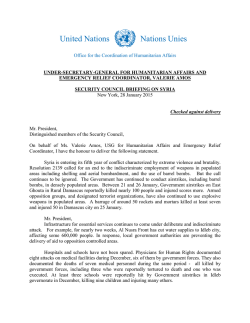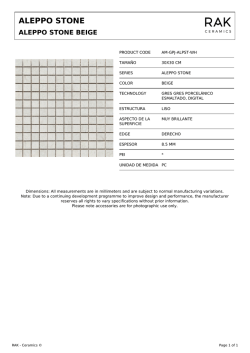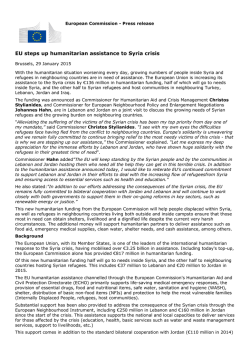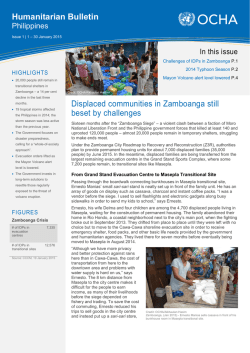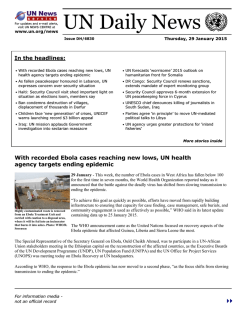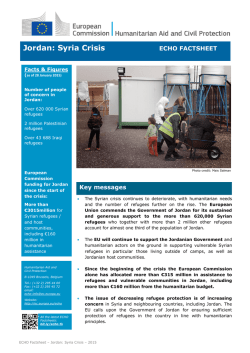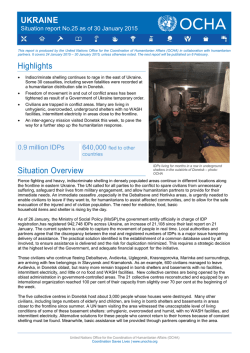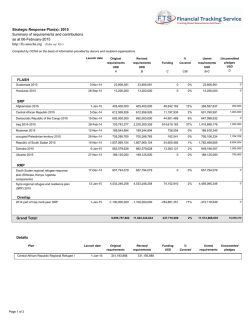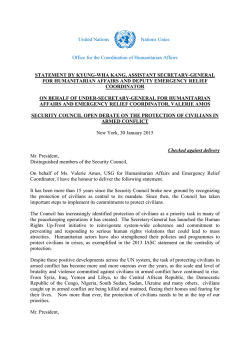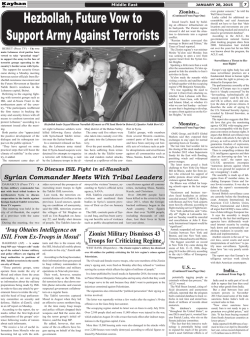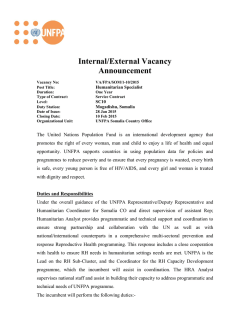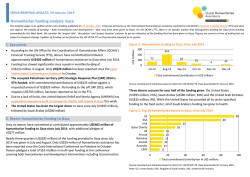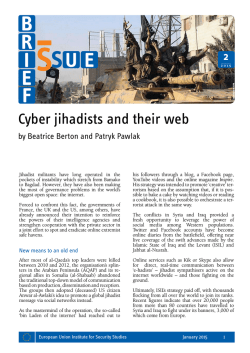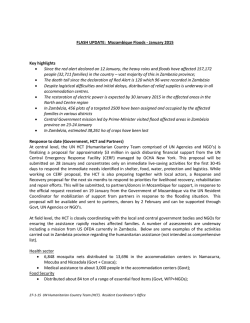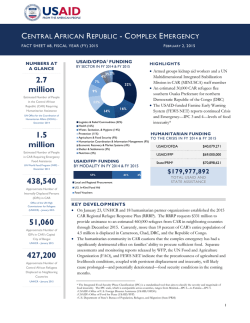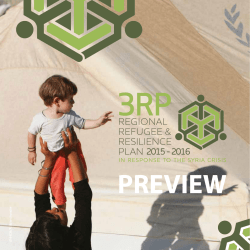
20150130_Humanitarian Bulletin_Issue#12
Humanitarian Bulletin Syria operations from Turkey Issue 12 | 19-30 Jan 2015 In this issue Humanitarian Access Constraints P.1 Humanitarian Context P.1 Response Update P.3 HIGHLIGHTS Winter Storm Response P.4 Clashes broke out in western Aleppo hindering ACU Disease Report P.4 humanitarian access to the HPF Update P.4 area. Winter Storm Damages Tents in IDP Settlements in Idleb © OCHA 2015 rural Bab al-Hawa border crossing has been closed since 26 January 2015 due to a security incident. YPG forces retook Ayn alArab city and a few surrounding villages. UN cross-border shipments Humanitarian Access Constraints Access trends remain generally unchanged during the reporting period but for the specific areas highlighted below. Humanitarian supplies and personnel are still generally able to reach their intended areas or beneficiaries in the northwestern Governorates, with occasional delays because of active combat. The map below indicates that the broad areas of control by all the parties to the conflict remain roughly the same during the reporting period. Major routes remain largely accessible in Government of Syria (GoS) controlled areas; while routes crossing into opposition-controlled areas remain contested. under the Security Council Resolution 2165/2191 reached 78,800 individuals in Aleppo, Idleb and Hama with UN Governorates. 6 trucks humanitarian supplies crossed Nusaybin/Qamishli the to Al- Hasakeh Governorate under Security Council Resolution 2139. Humanitarian Context FIGURES # of People in Need (PiN) # of IDPs 12.2 m 7.6 m # of reported camps in northern Syria 147 # of IDPs in reported camp settlements 175,517 Clashes between Al-Nusra Front and FSA-affiliates in western rural Aleppo: Clashes broke out between Al-Nusra Front and the FSA-affiliated faction Hazm Movement in western rural Aleppo on 29 January 2015, resulting in a proliferation of checkpoints and restrictions of humanitarian access to western rural Aleppo. Another opposition faction – Jabhat al-Shamia – has reportedly mediated between the groups and Syria | Turkey Humanitarian Bulletin | 2 offered to take over checkpoints and act as a neutral peace-brokering force. However, clashes continue and troop movements might impact on the frontlines with government forces in Handarat, Aleppo, thereby allowing government forces to advance in their encirclement of Aleppo city and threatening humanitarian access to Eastern Aleppo city. Shots fired in Bab al-Hawa border crossing lead to its closure: A Syrian individual fired shots at Turkish authorities at the Bab al-Hawa border after an altercation with Turkish security forces, leading Turkish authorities to close the border for humanitarian or commercial access since Monday 26 January. It should be noted that the closure of Bab al-Hawa is not related to the aforementioned fighting between Hazm and ANF in western rural Aleppo, as some have reported. Skirmishes between YPG and government forces in al-Hasakeh: Skirmishes took place between government forces and the YPG in al-Hasakeh city, prompting government forces to fire artillery at YPG positions. Fighting has since died down but this unprecedented escalation has raised fears that sustained fighting could have serious implications for humanitarian access in northern al-Hasakeh, an area which was known to be relatively quiet so far. YPG forces retake Ayn al-Arab city and a few surrounding villages: YPG forces have successfully expelled ISIL from Ayn al-Arab (Kobane) city, as well as retaking a few strategic defensive hilltops and several villages close to the city. PYD sources are now reporting between 5,000-10,000 civilians inside of the city, after some refugees in Turkey have begun to return, although this number has yet to be confirmed. Local sources are reporting that civilians inside of the city are in need of emergency assistance, given that most of the city has been destroyed, along with all health, water and electricity infrastructure. The map below shows the YPG's progress in expelling ISIL from Ayn al Arab city as of 29 January 2015. ISIL closes down SARC in Ar-Raqqa but cross-border actors are functional: ISIL has closed down the offices of the Syrian Arab Red Crescent in Ar-Raqqa governorate, as well as several small local charities, one of which was officially registered with the Syrian government. ISIL has appropriated its warehouses and equipment. Local sources report that local ISIL members tried to intervene in defense of the SARC and local charities but that the higher-level security branches of ISIL overruled them, insisting on closing them as a result of their purported links to the Syrian government. Several INGOs continue to operate cross-border into Ar-Raqqa governorate. There has been no https://www.humanitarianresponse.info/operations/stima | www.unocha.org United Nations Office for the Coordination of Humanitarian Affairs (OCHA) • Coordination Saves Lives Syria | Turkey Humanitarian Bulletin | 3 indication that ISIL intends to disrupt their work, although some mentioned that ISIL requested some extra background information on INGO staff members at the same time as they were closing down the SARC. Al-Nusra Front advances on government military airbase in Idleb: Al-Nusra Front has seized the town of Hamadiyat al-Shahad in Idleb, not far from the besieged government airbase of Abu Dhuhur. If Al-Nusra Front seizes the airbase itself, this would likely be a prelude to further offensives on a handful of remaining government military bases in Idleb, all of which protect Idleb city. In this sense, an Al-Nusra Front offensive on Idleb city remains a possibility, which could displace hundreds of thousands of civilians located inside of the city. Response Update On 17 December 2014, the Security Council decided through its unanimous adoption of resolution 2191 (formerly UNSC 2165).that United Nations agencies and humanitarian partners could continue, with notification to the Syrian authorities, to use the border crossings at Bab al-Salam, Bab al-Hawa, Al Yarubiyah and Al Ramtha The accumulated assistance provided through UN cross border assistance from Turkey since the adoption of UN SCR 2165 totals 1,713,918 people. During the past two weeks, shipments with humanitarian supplies consisting of FSL, NFIs and WASH items from WFP, UNHCR and IOM crossed the Bab al-Hawa border crossing. This aid is to assist 78,800 individuals in Aleppo, Idleb and Hama governorates. The Bab al-Hawa border crossing was closed late afternoon Monday 26 January for security reasons. As the border remained closed as of January 30, the crossing of UN assistance for around 50,000 individuals in Aleppo and Idleb governorates has had to be put on hold. The map below shows the accumulated assistance provided through UN cross border assistance from Turkey since the adoption of SCR 2165 (WHEN), which brings the total of people assisted with this aid to 1,713,918. Over the past two weeks, WFP shipped six truckloads of food assistance through Nusaybin/Qamishli under Security Council Resolution 2139 for distribution in al-Hasakeh governorate. In addition to the UN shipments, the Turkish Red Crescent (TRC) is facilitating the crossing of humanitarian shipments by NGOs and other actors through designated zero points along the Turkish border. Between 16 -29 January 2015, the TRC facilitated the crossing of 331 trucks during 10 shipment days using six border crossings. The 3W maps for cross-border humanitarian reach and activities have been finalized for December 2014. The maps provide an overview on the number of partners that are reporting on their https://www.humanitarianresponse.info/operations/stima | www.unocha.org United Nations Office for the Coordination of Humanitarian Affairs (OCHA) • Coordination Saves Lives Syria | Turkey Humanitarian Bulletin | 4 activities and the assistance provided per sector. In December 2014, Humanitarian partners from Turkey provided more than 1,000,000 beneficiaries with food assistance, close to 650,000 people with health support, distributed NFI kits to more than 520,000 people and provided 29,000 people with protection services. Humanitarian partners further assisted a cumulative total of over 500,000 people with education services and more than 3,000,000 people with WASH interventions including sustained water supply and hygiene kit distributions throughout 2014. The 3W maps can be accessed at: http://www.humanitarianresponse.info/operations/stima/infographic/turkey-syria-nearborder-humanitarian-reach-and-activities-november Winter Storm Response Settlements and IDP camps in Lattakia and Atmeh remain in need of tents as of 22 January 2015. Despite partners’ response efforts, access to settlements in Idleb and Atmeh remain problematic. The Camp Coordination and Camp Management (CCCM) sector organized a meeting focusing on winterization response on 22 January 2015 in Gaziantep, following a period of stormy winter weather. The discussion focused on preparedness, response and existing gaps. Humanitarian partners had identified heating fuel, tents and stoves as most urgent needs in 21 out of the 24 main camp clusters. Donors provided resources in consultation with CCCM members. Four partners provided heating fuel and kerosene covering most of the need and additional fuel was pre-positioned for distribution in case of further needs. Settlements and IDP camps in Lattakia and Atmeh remain in need of tents as of 22 January 2015. Despite partners’ response efforts, access to settlements in Idleb and Atmeh remains problematic. The CCCM also shared the results of its winterization survey revealing that INGOs are able to respond to the needs but face challenges with local delivery capacity. SNGOs stated that they would be able to deliver the assistance but lack sufficient resources to do so. The CCCM tracking also showed a small decrease in overall IDP numbers and with no new arrivals in IDP camps recorded. The total number of IDPs in camps now stands at 174,624 people. This trend is in line with the harsh winter conditions that have a negative compounding effect on the living conditions in IDP camps. Scabies and Lice Diseases Spread in Syria The Assistance Coordination Unit (ACU) released a red flag report on scabies and lice infestations among populations in war-affected Syria. According to the ACU, 7,600 cases of scabies and 10,000 cases of lice have been recorded in Syria since 2012. ACU’s enumerators surveyed schools in Al Sukkari, Tal al Zarazeer, Bustan al Qasr and Al Kallaseh and found: 30-50% of students have scabies while more than 25% of students have lice, As a consequence, most parents have stopped sending their children to school, which has negatively affected the education sector. 10,000 bottles of lotion for scabies treatment and 20,000 bottles of shampoo for lice treatment are needed. Humanitarian partners stated that 50 percent of the population in Aleppo city has been affected by the scabies outbreak and that 30,000 people had been provided with Permithrin (a solution for scabies treatment). The disease thrives in an environment of water scarcity and lack of electricity which curtails access to hot water. The treatment thus needs to be complemented with enhanced personal hygiene awareness campaigns and distribution of hygiene items such as soap. WASH sector members are planning a rapid and detailed WASH needs assessment beginning from 02 February 2015. Early plans to send assessment teams to Syria have been put on hold for security reasons. Humanitarian Pooled Fund (HPF) Update OCHA’s Humanitarian Financing Unit (HFU) will conduct a series of Grant Management System (GMS) trainings in Gaziantep and Antakya to familiarize eligible partners with the https://www.humanitarianresponse.info/operations/stima | www.unocha.org United Nations Office for the Coordination of Humanitarian Affairs (OCHA) • Coordination Saves Lives Syria | Turkey Humanitarian Bulletin | 5 Capacity Assessment Guidelines released online project management system. OCHA also released the Capacity Assessment Checklist and Guidelines for NGOs who are interested in becoming eligible partners of the HPF. Partners are invited to start the eligibility screening in preparation of the next allocation round planned for mid-February 2015. Relevant documents can be accessed at: for eligibility screening of HPF partners. http://www.humanitarianresponse.info/operations/stima/hpf. For further information, please contact: Barbara Shenstone, Head of Office, [email protected], Tel. (+90) 342 321 0426/27 Ali Gokpinar, Reporting Consultant, [email protected], Tel. (+90) 342 321 0426/27 https://www.humanitarianresponse.info/operations/stima | www.unocha.org United Nations Office for the Coordination of Humanitarian Affairs (OCHA) • Coordination Saves Lives
© Copyright 2025
